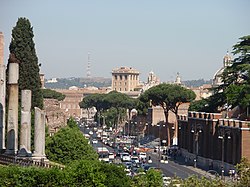List of streets in Rome

This article covers some of the main streets in Rome, Italy.
Via Cavour, Rome
.Via della Conciliazione
Via del Corso
Via dei Fori Imperiali

Via dei Fori Imperiali is a road in the centre of the city that runs in a straight line from the Piazza Venezia to the Colosseum.
The road, whose original name was "Via dell'Impero", was built during the dictatorship of
Via Giulia
Via Giulia was projected by Pope Julius II but the original plan was only partially carried out. This was the first attempt since antiquity to pierce a new thoroughfare through the heart of Rome and the first European example since antiquity of urban renewal. Via Giulia runs from the Ponte Sisto to the church of San Giovanni dei Fiorentini in a straight line, rather than following the tight curve of the Tiber. It became the most fashionable street for new construction for borghesi and for the Florentine community in the sixteenth century. Today its structures provide one of Rome's elite shopping streets, noted for its antique shops.
Via Margutta
Via Margutta is a small street in the centre of Rome, near to Piazza del Popolo, accessible as a small alley from Via del Babuino, in the old quarter of Campo Marzio, also known as "the foreigner's quarter", located near to the slopes of Mount Pincio. It is a place with many art galleries and fashionable restaurants, where before the Renaissance there were only modest craftsmen workshops and stables.
In the 1950s, after the film
Via Nazionale
Via Nazionale is a busy street in Rome from Piazza della Repubblica leading towards the Piazza Venezia.
Already begun as the via Pia, named in honour of Pope
Via Sacra
The
.